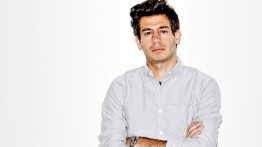With Shows at the Met and Storefront, Rayyane Tabet AR'08 Speaks at IDS
POSTED ON: March 4, 2020

Rayyane Tabet. Photo by Douglas Friedman
By any measure, Rayyane Tabet AR'08 has had an extraordinary year. The 2008 graduate of the Irwin S. Chanin School of Architecture had an exhibition last year at the Louvre and currently has two concurrent shows in New York, one, Arabesque, at Storefront for Art and Architecture until April 18, the other, Alien Property, will be on display at the Metropolitan Museum of Art until January 2021. And to hear the architect-turned-artist tell it, his works for these shows are all based on serendipity.
“Most of my work starts from these chance encounters,” he said in a recent interview with us. Although he splits his time between San Francisco and Beirut, he was in New York for his upcoming talk at Cooper as part of the Intra-Disciplinary Seminar (IDS). The subject next Tuesday will be the research he did for his current show at Storefront entitled “Arabesque.”
That exhibition is a good example of Mr. Tabet’s interests as well as his methodology. The show started when he came across a set of corbels in a salvage store in Berkeley that had been taken from a building designed by Julia Morgan (1872–1957). Mr. Tabet began digging and learned that Morgan was the first woman licensed as an architect in California, was the designer of approximately 700 buildings, and that she had attended L’école des Beaux Arts in Paris. He set the corbels and his research aside, knowing that they could eventually inform a future project. As it turned out, Mr. Tabet had another series of auspicious discoveries, this time in Beirut—a set of 300 drawings by Jules Bourgoin (1838–1908), an artist who carefully studied Islamic ornament, but was dismayed that interior designers had begun to use these without understanding their meaning or origins. Mr. Tabet purchased the drawings and Bourgoin’s last book, Précis de L’Arte Arabe et Materiaux (1892), and began another round of intensive research.
When he was given the opportunity to mount a show at Storefront, he realized that it would be a terrific opportunity to use the material he had accrued. “In some ways, the Storefront show is about my education as an architect,” he said, noting his discovery that Morgan and Bourgoin had been at the Academy at the same time—he as a teacher, she as a student. He has not been able to document whether or not they knew each other, but the point is moot: Mr. Tabet’s interest is in the ways that the school informed an understanding of “the Orient” to generations of artists and architects.
“When I was looking for a title, what kept coming back to me was ‘the arabesque,’” he said referring to a word meaning curved, ornamental line. He discovered that the word is a Western creation, a combination of “arabo,” meaning Arab, and “grotesque,” meaning an unusual shape. “I made an intervention on the façade [of Storefront]. It says “arabesque” in Arabic. in order for me to write it I had to transliterate it.” Anyone who can read Arabic will understand that this word, which was invented to categorize art in the Middle East, cannot truly be translated. It’s a word that demonstrates what Mr. Tabet calls “moments of slippage” revealing the often–hidden power dynamics behind language.
The show consists of work made from “leftovers of their practices,” the artist said referring to Morgan and Bourgoin. He constructed a sculpture from 20 of Morgan’s corbels and 300 collages from Bourgoin’s drawings that he cut apart and reorganized. The exhibition raises questions about appropriation and the subjectivity of the writing of history.
Mr. Tabet doesn’t see the upcoming program at Cooper on Tuesday as a traditional talk, more like a seminar with current students. That’s one reason he has chosen to speak in Room 315 in the Foundation Building instead of the usual venue for IDS, the Rose Auditorium. He has assigned students a well-known essay from 1919 by Austrian architect Adolf Loos entitled “Ornament and Crime.” The text provides is a revealing and disturbing window onto the racist underpinnings of modernism.
“How is a movement that was so transformative anthropologize and criminalize ‘the other.’ We edit out a lot of the darker parts of the story that we need to contend with and see the complexity.”
Mr. Tabet credits his “deep dive” method of art-making to studying with the late Professor Diane Lewis, who emphasized the critical importance of understanding the history of a site and its surroundings. ”I always attribute my approach to my training as an architect at Cooper at a time when the school was very interested in site analysis. Research was as important as the form we created—the idea that the building comes out of the site. I hold that very dearly and I do think that it’s informed my entire way of thinking.”




